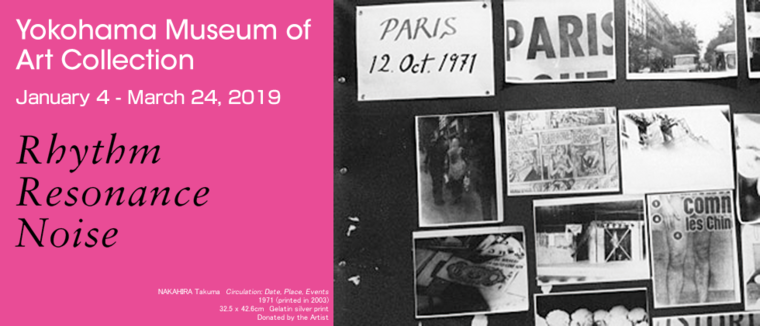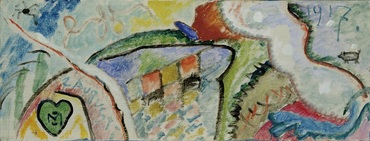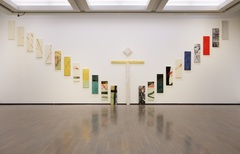Yokohama Museum of Art Collection January 4- March 24, 2019
Rhythm, Resonance, Noise

NAKAHIRA Takuma (1938-2015) "Circulation: Date, Place, Events" 1971 (printed in 2003)
32.5 x 42.6cm Gelatin silver print Donated by Mr. NAKAHIRA Takuma
Overview
I. The Dawn of Abstraction: Experiments 100 Years Ago
II. Postwar Abstraction: Resonating and Violent Forms
III. Expanding Form: Focus on "Nihonga" since the 1990s
[Special Feature: Shoji Fuku's "The Rhythm of Spring"]
IV. Forms of Repetition
[Foyer] Special Feature: Miyagawa Kozan
[Grand Gallery] Sculptures in the 20th Century
In this edition of the collection exhibition, titled "Rhythm, Resonance, Noise," focuses on exchanges between artists from a wide range of genres and the development of abstract expressions from the 20th century to the contemporary era. It is being held in conjunction with "Changing and Unchanging Things: Noguchi and Hasegawa in Postwar Japan," a special exhibition running concurrently at the museum.

Gabriele MÜNTER (1877-1962)
"Abstract Komposition" 1917
Oil on panel 23.4 x 59.4cm

Makoto FUJIMURA (b. 1960)
"The Resurrection 2" 1992
Mineral pigments, glue, kumohada(Japanese-paper), metal foil, metal powder
90.0 x 30.0cm each (22 pieces), 200.0 x 15.0cm, 10.0 x 160.0cm
"Junan Panel Series #32" 1991
25.0 x 25.0cm
Mineral pigments, glue, kumohada(Japanese-paper), metal foil, metal powder
both Donated by Mr. Kuniaki and Mrs. Katsuko UEDA (Sambi Shosha)

SATO Ado (1936-1995)
"Rainbow Forest"
1989
Silk screen (set of 7)
87.6 x 45.2cm each
Donated by Mr. SATO Ado
List of Works [987KB]

YAGI Lyota (b.1980) "Portamento (Symthesizer / Khoomei / Violin) No.2" 2006/2011
Ceramics, Long play records, Video (7’11,” 7’16,” 7’14,” Sound, Looped)
Dimensions Variable
Sections
I. The Dawn of Abstraction: Experiments 100 Years Ago
Abstraction in painting and sculpture emerged in Europe in the 1910s. Among the pioneers of abstract painting was Wassily Kandinsky, a theorist and painter of that era, while other artists known as Dadaists or Constructivists, based in cities such as Munich, Paris, and Moscow, were simultaneously carrying out a wide range of artistic experiments. Participants in these movements sought to reinterpret visual art both in theory and in practice, attempting to break down and theoretically reconstruct painting in terms of elements such as color, form, and motif, or using unprecedented materials for sculpture. These movements were also characterized by the building through collaboration of common theoretical foundations with artists working in other media such as music, literature, and theater.
It is known that the development of Kandinsky’s abstract painting and Arnold Schönberg’s atonal music were mutually inspired by the two men’s interactions. Meanwhile, Hans (Jean) Arp and the other Dada artists, who gathered in Zurich and based their activities at the Cabaret Voltaire, staged performances including atonal music and phonetic poetry recitation in conjunction with exhibitions of visual art, the members sharing the goal of deconstructing meaning and a spirit of destruction and rejection of the status quo. Approaches such as readymades, collage, and photomontage that grew out of the Dadaists’ artistic experimentation were eventually adopted by the Paris-based Surrealists, and remained one of the major currents in avant-garde art practice throughout the early 20th century.
II. Postwar Abstraction: Resonating and Violent Forms
News and images of the revolutionary creative experimentation emerging in Europe in the early 20th century reached Japan almost immediately, giving rise to new modes of expression, such as Saito Yoshishige’s abstract explorations of the zone between two and three dimensions. However, with the outbreak of World War II artistic innovation came to be restricted, and it was not until the mid-1950s that avant-garde art movements in Japan began to flourish.
The avant-garde group Gutai was formed in 1954. Many of its members created works evoking physical actions, such as Shiraga Kazuo, who devised a unique method of applying paint to canvas with his feet, and Tanaka Atsuko, who staged a performance wearing a dress made of colorfully painted, active light bulbs, and went on to produce abstract paintings recalling networks of bulbs and wiring. Their orientation toward performance was also in parallel with trends in the United States, which became the center of the art world after World War II.
Abstract Expressionism, which emerged primarily in the US in the late 1940s, emphasized dynamic action and painting’s role as a record of the painter’s movements. Later, in the 1950s and 1960s, Robert Rauschenberg and other artists described as Neo-Dadaists took an immediate, improvisatory approach to engaging with the actual world and media environment around them, for example incorporating everyday objects into their works.
In this we see similarities with works by photographers like William Klein and Nakahira Takuma, who boldly defied photographic taboos with pictures that were intentionally rough, blurred or out of focus. The interrelation between abstraction and bodily movement pursued throughout the 20th century has been inherited by contemporary artists, such as Takamine Tadasu and Yagi Lyota, who are producing video installations today.
III. Expanding Form: Focus on ”Nihonga” since the 1990s
In this section, we present a variety of changes in Japanese painting that emerged between the ’90s and the ’00
In the mid-’80s, a number of artists who, while strongly influenced by Western art trends of the period, explored new expressions in painting using traditional ”Nihonga” (Japanese-style painting) materials such as natural mineral pigments, ”gofun” (a white pigment made from oyster and clam shells), and gold and silver leaf. Artists such as Kawashima Junji and Saito Norihiko, who studied at Tokyo University of the Arts, referenced traditional techniques and subject matter and at the same time, they accentuated the physicality of their materials.
In Makoto Fujimura’s ”The Resurrection 2,” the abstract picture, executed on a Japanese-paper panel, extends like an altar across the entire wall. While highlighting the beauty of materials, including pigment, leaf, and powder, Fujimura approaches the support medium and display method in an unrestricted manner, creating a radiant, sublime space.
Ono Yuzo is probably more interested in the traces left by the act of painting rather than the painting itself. In ”Untitled (From White to White),” he systematically folded a piece of Japanese paper, covered with layers of mineral pigments, to depict a grid made up of faint lines with the appearance of grooves that emerged after the paint had peeled off. Ono’s work might be seen as an attempt to explore the outer limits the creative act.
Mise Natsunosuke has constantly questioned what constitutes ”Nihonga” while employing materials associated with the genre. Both ”The ’Nihonga’ Destruction Theory” and ”The ’Nihonga’ Restoration Theory” were made during a year the artist spent in Italy. Using a support medium covered solely with Japanese paper, Mise painted fragments of strangely shaped rocky mountains and clouds that recall Chinese-style ink paintings, and Italian landscapes depicting churches and bridges, giving rise to a chaotic worldview. Reaffirming his own position by working in a foreign country, Mise seems determined to create contemporary paintings that transcend tradition.
Special Feature: Shoji Fuku’s ”The Rhythm of Spring”
Shoji Fuku (1910-2002) was one of the most prominent female painters in Japanese postwar art. Shoji started making her work before the war and began showing it after the conflict had ended. By studying the lifestyle and beliefs of people in Japan’s Tohoku region, where she was based at the time, and traveling to China, India, and Egypt, Shoji established herself as a painter with a series of works dealing with customs and ruins in these areas. In her later years, Shoji turned her attention to nature in Japan, and made a large body of works that were inspired by landscapes in the Hokkaido and Tohoku region.
According to Shoji’s son Hitoshi, who frequently accompanied her on her travels, when Shoji came across a landscape that she liked in the course of a research trip, she would quickly take out her sketchbook and begin drawing. In many of Hitoshi’s photographs, Shoji can be seen leaning forward with her sketchbook on her knee as if she has become one with her subject and is attempting to grasp its essence.
A note contained in a sketch for ”The Rhythm of Spring” tells us that the work grew out of the artist’s visit to Oirasekeiryu in Aomori Prefecture. Along with the relaxed lines and colors, the note brings the artist’s production process to life.
IV. Forms of Repetition
In this section, we move away from historical eras and genres of art, and present a group of works based on the keyword “repetition.” Like a comfortable rhythm created by sounds with the same intensity or pitch emitted at a fixed interval, repetition is used in visual art as a means of producing a rhythmical form.
Sato Ado made an image of a tree by combining round and arched shapes. Taking advantage of the special qualities of the print medium, which makes it possible to repeatedly print the same image, he created a forest of trees in seven different colors. The work is imbued with a formal rhythm made up of overlapping arcs and a rhythm created by the gradually changing colors. Working in concert, these rhythms splendidly reproduce the beauty of a rainbow, consisting of colored bands arranged in concentric circles.
Next, let’s take a closer look and try to identify traces of the artists’ manual work. Take, for example, the accumulation of lines that make up You Young-Hee’s drawing, the carving marks in Yoshida Ayomi’s print, and the weave of Sekijima Hisako’s basket. There is also Ishida Takashi’s ”Where Light Falls.” Using film and painting, Ishida reproduces the creation of the work, the result of a mind-boggling accumulation of actions, through vivid repetitions that occur right before our eyes.
Amassing a number of repeating forms can also create a group. See, for instance, Kim Mi-Hyang’s depiction of waves of rice plants or Onchi Koshiro’s photograph of countless wriggling insects. By focusing on the uniformity of a group of elements, we overlook the unique characteristics of each individual part. But when we turn our attention to the differences and disparities between them, we begin to notice the noise within the harmonious, consistent rhythm. Yanagi Yukinori’s ”Hinomaru” (Japanese National Flag), consisting of an aggregation of round name stamps, conveys the unified and uniform nature of the people who constitute the Japanese nation. On the other hand, each stamp has a different name, accentuating the fact that each person is an indispensable individual. The work is distinguished by its depth and breadth, conveying a multilayered message that changes depending on our point of view.
Special Feature: Miyagawa Kozan
In 1871, the ceramicist Miyagawa Kozan I (1842-1916) moved from Kyoto to Yokohama, where the port had recently opened, and founded the Makuzu kiln in what is now Kanoedai, Minami-ku to manufacture ceramic ware for export to the West.
In the early years, he exported pottery employing a ”takauki-bori” (high relief) decorative technique, which was highly lauded at international expositions around the world and gained popularity under the name “Makuzu-ware.” When exports began falling off, he ceded operation of the kiln to his successor Kozan II and focused on research into Qing Dynasty (1636-1912) Chinese ceramics and glazes, producing enamel ceramics featuring complex designs with decorative painting beneath glazes. In 1896, he was appointed Imperial Household Artist in recognition of his achievements in leading the Meiji-era (1868-1912) ceramics industry.
Makuzu ware continued to be produced until the death of Kozan III in an air raid on Yokohama in 1945, and Makuzu was widely known as one of Yokohama’s greatest kilns.
Outline
| Dates | January 4 (Fri.)-March 24 (Sun.), 2019 |
|---|---|
| Open Hours | 10:00-18:00 *Open until 20:30 on March 2 (Sat.), 2019 *Admission until 30 minutes before closing. |
| Closed | Thursdays(Except March 21), January 11, March 22, 2019 |
| Organized by | Yokohama Museum of Art [Yokohama Arts Foundation] |
Ticket
| Adults | 500(400) |
|---|---|
| University students High school students | 300(240) |
| Junior high school students | 100(80) |
| Children under 12 | Free |
*( )= Group of 20 or more (pre-booking required.)
*Free Admission for high school and younger student with valid ID on every Saturday.
*Free Admission on February 24(Sun.)
*Visitors with disability and one person accompanying them are admitted free of charge. (Please present a certificate at the entrance.)
*Collection gallery is available with a ticket of Special Exhibition.









